Yves GARY Hits: 4831
Category: 1895 : CHALLENGE N°9

 August 15, 1895 : official measurements
August 15, 1895 : official measurementsThe Defender and the Vigilant will be floated into the dry docks in the Erie Basin at high tide, about 7 o'clock to-morrow morning. The Defender will occupy Dock No. 1 and the Vigilant Dock No. 2. So any one who pays a visit to the basin will have a chance to compare the models of the two yachts.
The racing lengths of the two boats will be kept secret until the Valkyrie has been officially measured for the cup races. The races will be sailed and the actual difference in time between the two boats will be known, but the time allowance will be kept secret, and none but members of the Cup and Regatta Committees will know how much one boat is better than the other.


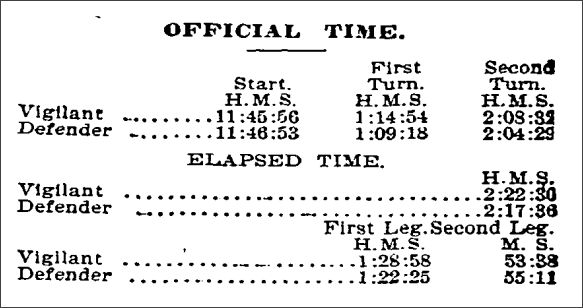 August 20th : first race
August 20th : first raceThe Vigilant beat the Defender yesterday because the latter was not quite so well prepared as the former to meet that capricious child of nature, the weather outside of Sandy Hook. The contest was the first of the trial races to decide what seems to be already a settled matter, namely, which of the two yachts is to meet the formidable-looking product of George L. Watson’s fancy, called Valkyrie III, in a struggle for the America's Cup.
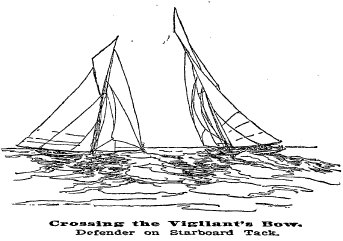 Incidentally, yesterday's race was for a handsome cup, valued at $1,000, given by John Jacob Astor. By the laws of yacht racing the Vigilant wins that cup, although the Defender proved to be fleeter of foot. In yachting, however, the race is not always to the swift. Some persons would say that the Vigilant had great luck, but there are many old yachtsmen who will declare that she fairly earned her victory by being better prepared than her opponent for a hard thrash to windward in a freshening breeze and a growing sea. She certainly lost nothing by handling either, for she was sailed with the finest skill in the use of the helm, with perfect judgment in starting and in setting canvas, and with admirable smartness in making and taking in sail.
Incidentally, yesterday's race was for a handsome cup, valued at $1,000, given by John Jacob Astor. By the laws of yacht racing the Vigilant wins that cup, although the Defender proved to be fleeter of foot. In yachting, however, the race is not always to the swift. Some persons would say that the Vigilant had great luck, but there are many old yachtsmen who will declare that she fairly earned her victory by being better prepared than her opponent for a hard thrash to windward in a freshening breeze and a growing sea. She certainly lost nothing by handling either, for she was sailed with the finest skill in the use of the helm, with perfect judgment in starting and in setting canvas, and with admirable smartness in making and taking in sail.
This is not saying that the Defender was badly managed. The boat was well sailed, but E. A. Willard and Capt. Charles Barr had a little the better of the contest of wits. They got the best of the start, and on the first tack of the beat to windward, with which the race began; made an excellent display of the Vigilant’s abilities.
On the second tack, the sea, which had been broad off the starboard bow, came sharp on the port bow, and increasing every minute, checked the Vigilant's headway, while it had far less effect in the Defender. On the run home Capt. Barr put his mainsail to port, and Capt. Haff put his to starboard.
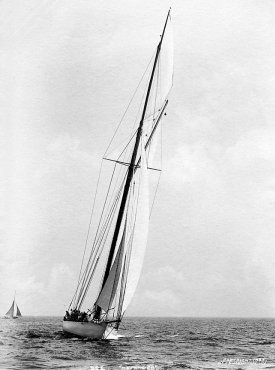 The Regatta Committee subsequently ordered the boats to go over the course a second time, the result being that the Defender had to gybe to round the lightship, while the Vigilant simply, hauled by the wind, and thus gained fully a minute of time.
The Regatta Committee subsequently ordered the boats to go over the course a second time, the result being that the Defender had to gybe to round the lightship, while the Vigilant simply, hauled by the wind, and thus gained fully a minute of time.
It was soon after the second round had begun that the Defender was obliged to give up the contest, because, as Mr. Iselin subsequently stated, her main rigging had pulled out so slack that it was feared she might lose her mast in one of her dives into the opposing seas. The fact that the Defenders standing rigging was not in condition to support her enormous mast with its weight of spars and pressure of canvas in first-class racing weather such as that of yesterday must be permitted to speak for itself; but there was obviously no course open to Mr. lselin and his associates but to abandon the contest and not risk wrecking their vessel with the cup races so close at hand.
It was a good deal better to find a weak spat yesterday than it would be to find it on Sept. 7. Of course, it seems as if weaknesses ought all to have been remedied before this.
 Publié le 21 August 1895 |
VIGILANT VICTOR, DEFENDER INJURED. |


 August 29th : second race
August 29th : second raceAfter a week at Bristol, Defender was ready for another trial against Vigilant, and the boats met for a second time August 29th. Another cup was offered by Col. Astor. The course was triangular, eight miles to a leg. The wind was N. W., a good sailing breeze.
The yachts had a reach on the first leg of the course and a run on the second, while the third, by reason of shifting winds and a short squall, became a close-hauled reach.
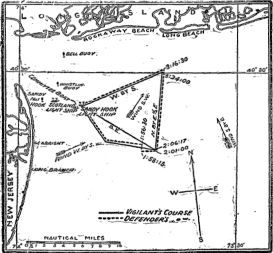 When the preparatory signal was given at 11:10 o'clock the Defender was to the north of the line, the Vigilant to the south.
When the preparatory signal was given at 11:10 o'clock the Defender was to the north of the line, the Vigilant to the south.
With three minutes left, the yachts were drawing toward each other. The Defender had the right of way, but Capt. Barr tacked the Vigilant across the Defender’s bow, and was leading and to windward of the keel boat. This did not seem to please Capt. Haff, for he first tried to squeeze the Vigilant, but a moment later had the Defender's sheet eased off and squared for the line. The Defender quickly ran through the Vigi1ant’s lee, and when twenty seconds remained before the signal the Defender’s balloon jibtopsail was broken out. At 11:20 the starting signal was given, and at 11:20:28 the Defender crossed the line, the Vigilant crossing a couple of lengths behind at 11:20:40.
As the Vigilant crossed, the balloon jib topsail was broken out, and then her staysail. The compass course of the first leg was southeast, and the wind was west by south, so that it was over the starboard quarter. The staysails and jibs were taken in on both yachts, and, with their balloons drawing well, they made good headway in the light air. The Defender was slowly but surely drifting ahead, and at 12:45 she got a little puff that sent her still further ahead. So far, she was having all the luck, and seemed to be able to catch every little ripple that came over the water.
The Defender was slowly but surely drifting ahead, and at 12:45 she got a little puff that sent her still further ahead. So far, she was having all the luck, and seemed to be able to catch every little ripple that came over the water.
At 1:10 o’clock, Defender set her jib and staysail and took in the big balloon jib topsail. A No. 1 jib topsail was run up in place of the balloon and broken out five minutes later.
The wind freshened a little at 1:40 o’clock, the Defender heeled a little under the pressure, she moved fast through the water, and a little foam curled round her bow, ran along her sides, and danced on the wave she drew behind her. The Vigilant was as stiff as a church steeple. Her sails hardly drew at all, and there were no signs of her moving on the water. It was again several minutes before this breeze reached the Gould boat.
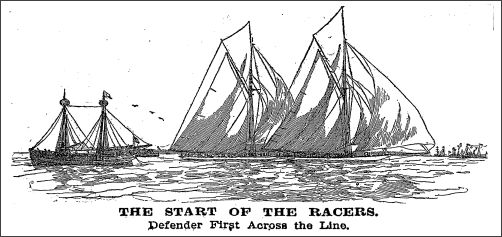 At 1:55 o'clock the Defender was approaching the mark and her big balloon was stopped up and out on the bowsprit ready to hoist. The Defender, however, could not fetch the mark, which had to be left on the port hand, and at 1:06:30 she tacked to port. The Vigilant by this time had got the breeze and she was coming along in something like her old form. As soon as "Charlie" Barr saw the Defender tack he gave the Vigilant a sharp luff and began to squeeze her up to fetch the mark. The Defender held on this port tack until 1:53:15, and then she tacked again to starboard. It took her 27 seconds to go about, which was quick, considering the lightness of the wind.
At 1:55 o'clock the Defender was approaching the mark and her big balloon was stopped up and out on the bowsprit ready to hoist. The Defender, however, could not fetch the mark, which had to be left on the port hand, and at 1:06:30 she tacked to port. The Vigilant by this time had got the breeze and she was coming along in something like her old form. As soon as "Charlie" Barr saw the Defender tack he gave the Vigilant a sharp luff and began to squeeze her up to fetch the mark. The Defender held on this port tack until 1:53:15, and then she tacked again to starboard. It took her 27 seconds to go about, which was quick, considering the lightness of the wind.
When she tacked she was close to the mark, which she wore round at 2:01:00. The Vigilant followed at 2:06:17. The eight miles of reaching had taken the Defender 2 hours 40 minutes 32 seconds and the Vigilant 2 hours 45 minutes 37 seconds, so the Defender had beaten the Vigilant over the first leg of the course 5 minutes and 5 seconds.
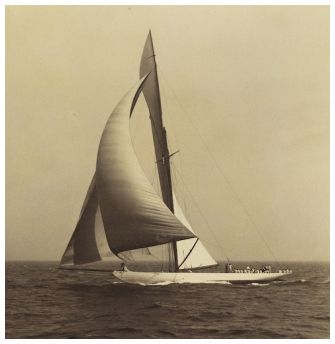 The course of the second leg was north by east, half east, and the wind was from the south by east. The Vigilant carried her spinnaker well forward and appeared to be doing very well. This point of sailing is her stronghold, and many expected her to pick up on the Defender, especially if the wind freshened very much.
The course of the second leg was north by east, half east, and the wind was from the south by east. The Vigilant carried her spinnaker well forward and appeared to be doing very well. This point of sailing is her stronghold, and many expected her to pick up on the Defender, especially if the wind freshened very much.
By this time heavy black clouds had gathered in the west. A squall was gathering. It had an ugly look, and if it broke while the yachts were running, there would be some lively work done to get in the light sails without any damage being done. At 2:30 o'clock rain began to pour down, and in a few moments the sails were soaking wet. The rain added to every one’s discomfort. The heat was almost intolerable, and the rain drove every one under cover and out of what little air there was.
The rain soon passed over, and, for a while, the angry look in the sky disappeared. The sun shone out brightly and soon dried the sails, too.
The Defender took in her balloon jib topsail at 3:01 when nearly two miles from the second turn. Her jib and stay sail were set at once. The Vigilant set her headsails at 3:13:30, took in her balloon, and set her baby jibtopsail up in stops. Both yachts were moving through the water well, and the Defender had increased the distance between the two. 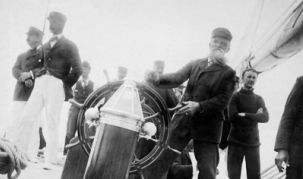 At 3:14 the Defender’s spinnaker was taken in and a minute later her boom jibed, and, hauling on the wind, bore down on the mark. She turned it at 2:16:30. The Vigilant carried her spinnaker until 3:20:20, sent up her baby jibtopsail, and broke it out at 3:22:10, jibing as she did so. The Vigilant made a smart jibe, and she turned the mark at 3:24. The eight-mile run had taken the Defender 1 hour 15 minutes 30 seconds, and the Vigilant 1 hour 17 minutes and 13 seconds, so that the Defender had gained 2 minutes 13 seconds on the run.
At 3:14 the Defender’s spinnaker was taken in and a minute later her boom jibed, and, hauling on the wind, bore down on the mark. She turned it at 2:16:30. The Vigilant carried her spinnaker until 3:20:20, sent up her baby jibtopsail, and broke it out at 3:22:10, jibing as she did so. The Vigilant made a smart jibe, and she turned the mark at 3:24. The eight-mile run had taken the Defender 1 hour 15 minutes 30 seconds, and the Vigilant 1 hour 17 minutes and 13 seconds, so that the Defender had gained 2 minutes 13 seconds on the run.
The last leg of the course was west by south to the finishing line off Scotland Lightship. The wind was from the south-west. This made it a close haul and there was soon to be some fun. The wind was freshening fast and it looked very squally in the southwest. Fifteen minutes after the Defender turned the squall struck. The wind swept over the water at a merry pace and soon whipped it so that white caps danced on the waves as the first puff struck.
 Capt. Huff luffed the Defender, but the yacht got a knockdown and her lee rail went under. She righted at once and staggered into the wind, which was coming in strong gusts, Her new mast and spars were having a rare test and they stood well. Capt. Haff gave a rare exhibition of seamanship. The Defender was beautifully handled and presented a fine picture as she buffeted the wind and sea. Mr. Iselin was watching the topmast and he seemed to be wondering if it would stand.
Capt. Huff luffed the Defender, but the yacht got a knockdown and her lee rail went under. She righted at once and staggered into the wind, which was coming in strong gusts, Her new mast and spars were having a rare test and they stood well. Capt. Haff gave a rare exhibition of seamanship. The Defender was beautifully handled and presented a fine picture as she buffeted the wind and sea. Mr. Iselin was watching the topmast and he seemed to be wondering if it would stand.
At 3:31:15 the squall was at its height, and the upper part of the bridle on the club at the clew of the jib parted. In an instant the jib pulled free from the sheet and flapped about in the wind. Then the club snapped like tinder, and the batten flew out of the sail, and rattled down on the deck, to be blown the next moment into the water. The crew jumped to get the sail but before they could secure it, it had split in two. The torn pieces were lowered, and after a four-minute struggle were taken in and stowed away. A new jib was got out, sent up in stops, and broken out at 3:29 :00.
 In the meantime the squall had struck the Vigilant. Capt. Barr was prepared for it. The baby jib topsail was lowered, and at 3:29:00 the crew worked like magic. It is seldom a big sail is taken in as quickly as this was. It seemed to disappear all of a sudden.
In the meantime the squall had struck the Vigilant. Capt. Barr was prepared for it. The baby jib topsail was lowered, and at 3:29:00 the crew worked like magic. It is seldom a big sail is taken in as quickly as this was. It seemed to disappear all of a sudden.
The breeze died down fast after the squall passed, but the Defender carried it long enough to get across the finishing line at 4:10:08, and then the Vigilant had to struggle along in the light air again. It took 18 minutes for her to make up the distance between the two boats, but, if the breeze had held out, it would not have taken much more than half that time.
The Vigilant crossed the finishing line at 4:28:23. It had taken the Defender 0:53:38 on the last leg, and the Vigilant 1:04:23. On the close reach the Defender beat the Vigilant 10 minutes 45 seconds.
After crossing the line both boats took tows and went to the mooring in the Horseshoe. The America's Cup Committee held a meeting on the tug Luckenbach and evidently not being satisfied with the race ordered another one for the day after from the Scotland Lightship at 11 o'clock.
Defender beat Vigilant 16 m. 34 s., allowing 1 m. 29 s. The boats encountered a squall on the third leg, but weathered it without accident.
 Publié le 30 August 1895 |
HONORS WITH THE DEFENDER |

 August 30th : third race
August 30th : third race
The third trial race between the Defender and the Vigilant was the best of all. The Defender yesterday proved her superiority to the Vigilant beyond all possibility of doubt.
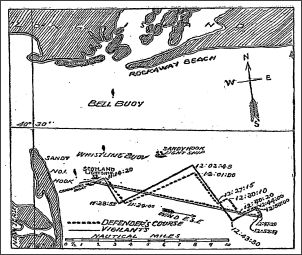 When the preparatory signal was given promptly at 11 o'clock, the wind was blowing about 10' knots an hour from the east-southeast. There was a steady roll on the water, the usual Atlantic roll that Designer Watson claims plays such havoc with his ideas as portrayed in the models of his yachts. The wind caught the top of these waves, and here and there whipped them into tiny flecks of white foam.
When the preparatory signal was given promptly at 11 o'clock, the wind was blowing about 10' knots an hour from the east-southeast. There was a steady roll on the water, the usual Atlantic roll that Designer Watson claims plays such havoc with his ideas as portrayed in the models of his yachts. The wind caught the top of these waves, and here and there whipped them into tiny flecks of white foam.
It was a good sailing clubtopsail breeze, and there was not enough sea to retard the progress of the yachts. When the blue peter was hoisted on the Lucketnbach the Vigilant was on the port tack, south-west of the lightship, standing in toward the New-Jersey shore. The Defender was on the starboard tack east of the lightship, and standing over toward Long Island. In a few minutes the Defender gybed and stood over to the west. The crew of the Vigilant quickly ran the baby jib topsail up in stops, and then Capt. Barr tacked his ship and stood for the southwestern end of the line.
When two and one-half minutes remained of the preparatory time the Defender wore round, and on the starboard tack went for the same end o the line to which the Vigilant was heading. Then the Vigilant’s baby jib topsail was broken out. The boats were drawing dangerously, near each other, and both Captains seemed to have miscalculated by a few seconds. Capt. Barr luffed the Vigilant, and the Defender bore off a little.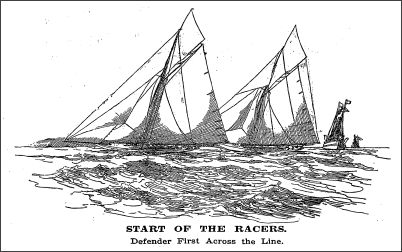
At 11:30 the starting signal was given. Capt. Haff shot his boat over the line before the whistle had stopped blowing, and just 10 seconds later the Vigilant crossed close under the stern of the committee boat, the tug Luckenbach. The official times of the start were:
Defender . . . 11:10:08
Vigilant . . . 11:10:18
Capt. Barr luffed the Vigilant in between the Luckenbach and the Defender, but Capt. Haff was not going to allow that, and, giving the Defender a full, she ramped through the Vigilant's lee, and in less than a minute drew clear of the Gould boat and took the lead. The Vigilant tailed on behind the Defender, and the two racers were fairly off. It was a beautiful start, one of the prettiest seen this year. Both boats were beautifully handled, and honors were even between Capts. Haff and Barr.
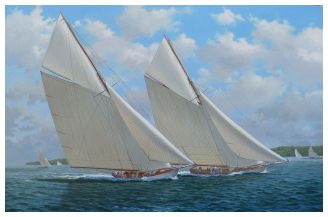 The yachts were heading to the east-southeast, and the sea was catching them under the starboard bow. Capt. Barr did not seem to like the stern chase, and at 11:14:20 he tacked the Vigilant to port, but her head sails had only begun to shake when the Defender spun around and was full and away on the port tack before the Vigilant had got round. The Defender was then to windward of the Vigilant, and Commodore Gould, who in Thursday's race had a good chance to admire the Defender‘s stern, was given an opportunity to admire the new boat broadside on, but on the leeward side. The Vigilant was given a full again and she dropped to leeward but the Defender footed just as fast as the old boat, and held on to her course. The two yachts were traveling fast and the wind seemed to have freshened just a little. They held on the port tack just 14 minutes, and at 11:28:55 the Vigilant went about; and 5 seconds later the Defender followed. The Defender was then about one-eighth of a mile to windward.
The yachts were heading to the east-southeast, and the sea was catching them under the starboard bow. Capt. Barr did not seem to like the stern chase, and at 11:14:20 he tacked the Vigilant to port, but her head sails had only begun to shake when the Defender spun around and was full and away on the port tack before the Vigilant had got round. The Defender was then to windward of the Vigilant, and Commodore Gould, who in Thursday's race had a good chance to admire the Defender‘s stern, was given an opportunity to admire the new boat broadside on, but on the leeward side. The Vigilant was given a full again and she dropped to leeward but the Defender footed just as fast as the old boat, and held on to her course. The two yachts were traveling fast and the wind seemed to have freshened just a little. They held on the port tack just 14 minutes, and at 11:28:55 the Vigilant went about; and 5 seconds later the Defender followed. The Defender was then about one-eighth of a mile to windward.
The Defender was leading and gradually drawing ahead, but so far she had not done as well as was expected of her. At noon, the two yachts passed about half a mile south of the Sandy Hook Lightship.
 The Defender at 12:01 tacked to starboard, the Vigilant following at 12:02:45. It took the Vigilant just 25 seconds to get about, which was very quick for this boat. For some reason, the Defender began to do better or the Vigilant worse, for the syndicate boat at once began to draw ahead.
The Defender at 12:01 tacked to starboard, the Vigilant following at 12:02:45. It took the Vigilant just 25 seconds to get about, which was very quick for this boat. For some reason, the Defender began to do better or the Vigilant worse, for the syndicate boat at once began to draw ahead.
At 12:27:15 the Defender tacked to starboard. She held this tack until 12:30:10, and then went about again on the port tack, being well to windward of the Vigilant. The Defender tacked again at 12:40:20 to starboard, and then she seemed to be fairly flying through the water. She seemed to glide over the waves and hardly make any motion. She heeled easily, too, and many of her admirers declared she would be ten minutes ahead at the outer mark. The Vigilant held on the port tack until she had crossed the Defender’s wake, and then she tacked at 12:43. They were then nearing the mark and would weather it on the next tack. The Defender kept on until she could fetch, and at 12:44 tacked to port. Capt. Haff had judged things finely, and as she approached the mark he had to luff the Defender out to keep from fouling it. The Vigilant tacked for the mark at 12:50, and the official times taken as the luffed around it were:
Defender, 12:47:25
Vigilant, 12:53:02.
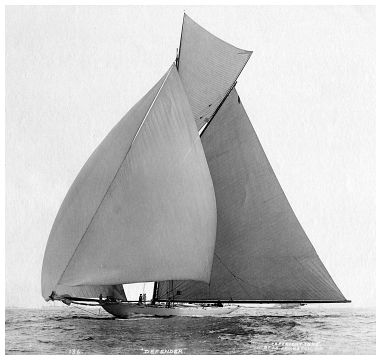 The Defender had taken 1 hour 37 minutes and 17 seconds to beat the ten miles; and the Vigilant had taken 1 hour 42 minutes, 44 seconds. This showed a gain of 5 minutes 27 seconds for the Defender.
The Defender had taken 1 hour 37 minutes and 17 seconds to beat the ten miles; and the Vigilant had taken 1 hour 42 minutes, 44 seconds. This showed a gain of 5 minutes 27 seconds for the Defender.
Now for the run home. In the fresh breeze it gave promise of being a close and exciting one, and the yachts being so close together, a lot depended on the way the sails were handled. The mark had been left on the starboard hand, and those on the yachts evidently thought the wind might haul more to southward; so their booms were jibed over to port. The Defender jibed at 12:47:40, and the Vigilant a few seconds after she passed the mark.
The jibes were made with the sheets flat aft and were easy ones. Main sheets were eased off, and the crews set to work to get the spinnakers out. The Defender’s boom was lowered out at 12:49:30; then her spinnaker was hauled outboard and broken at 12:50:30, just three minutes and five seconds after rounding the stake. The Vigilant’s spinnaker was broken out at 12:55:20, two minutes and eighteen seconds after passing the mark.
The Wind filed the big sails at once, and both yachts seemed to Jump forward as the wind got into their big sails. Balloon jib topsails were next set, and then, with all the crews well aft except the lookout men forward, they were well on the ten-mile journey home. Every inch of their big sails was drawing in the fresh breeze, and the sun shone on their big canvas and made it glisten like silk.
The Vigilant gradually picked up on the Defender, so that when about five miles had been covered, the distance between the two was only half what it was at the start of the run down the wind.
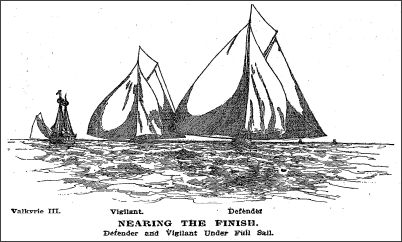 The wind was lightening, and the big sails began to droop. When south of the Sandy Hook Lightship the balloon jib topsails were hanging like rags. The puffs would fill them, and then they would droop again. On they went for the line, the Vigilant being dangerously near the Defender in case the wind should freshen, but it did not, and the Defender crossed the line first. The Vigilant’s balloon jib topsail was doing her no good, and it was taken in at 2 o'clock. The Vigilant had closed up considerably on the Defender, but, the wind having dropped, it took her some time to reach the finishing line. The times at the finish were:
The wind was lightening, and the big sails began to droop. When south of the Sandy Hook Lightship the balloon jib topsails were hanging like rags. The puffs would fill them, and then they would droop again. On they went for the line, the Vigilant being dangerously near the Defender in case the wind should freshen, but it did not, and the Defender crossed the line first. The Vigilant’s balloon jib topsail was doing her no good, and it was taken in at 2 o'clock. The Vigilant had closed up considerably on the Defender, but, the wind having dropped, it took her some time to reach the finishing line. The times at the finish were:
Defender .......... ..................2:02:18
Vigilant .......... ..................2:07:40
The run home had taken the Defender 1 hour 14 minutes 53 seconds, and the Vigilant 1 hour 14 minutes 38 seconds; so that the Vigilant gained 15 seconds on the Defender.
The Defender continued up the bay, and anchored off the Atlantic Yacht Clubhouse. The Vigilant went into the Horseshoe. The Defender wins the two cups given by John Jacob Astor. The conditions to govern the contest were the winner of the first race to take one cup, the winner of the second race the other. If these two races were won by different yachts they were to race again, the winner of the third race to take the third. The Vigilant won the first race, the Defender the second and third, so the Defender gets the cups.
Ater the race the following announcement was made by the Cup Committee:
The Defender will be put in the dry dock in the Erie Basin to be got ready for the cup races which begin next Saturday. The Valkyrie will be docked next Wednesday.
 Publié le 31 August 1895 |
THE FINAL TRIAL RACE BETWEEN THE DEFENDER AND VIGILANT |
Page |
Page |
